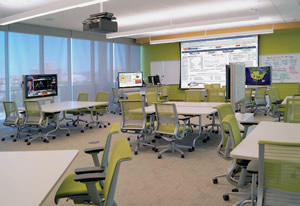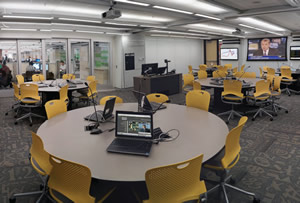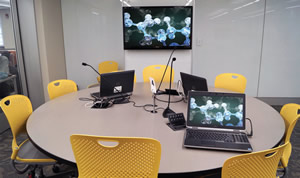The Classroom Reimagined

UMKC Bloch Executive Hall - BNIM/MRY Architects
PHOTO COURTESY OF THE SEXTANT GROUP
In the age of the digital native, information on campus is no longer confined to physical textbooks, chalkboards or even classrooms. When students walk into class with Google on their smartphones, the instructor no longer holds a monopoly over content. This begs the question: “Is the classroom becoming irrelevant?”
Not likely, but there is a clear trend in classroom design that reflects more active pedagogies and student-centric team-based learning models. Many colleges and universities are incorporating new learning spaces on their campuses that reflect the growing pedagogical movement toward digitally collaborative active learning environments.
Blending Classroom and Online Learning
In this age of personal computing, a significant amount of learning and communication is done through the computer screen, which we cannot forget when designing classrooms. Unfortunately, most large traditional classrooms and lecture spaces primarily support didactic style learning rather than other pedagogies emerging in the marketplace.
In the last few years, free online offerings, like those from universities aligned with Coursera and EdX, allow students to take college level courses online anywhere, anytime for little or no cost. This raises a related question: Are classrooms relevant when online content that was once available only on campus is now readily available anywhere?
We can answer that categorically, “Yes!” Following are four examples of universities taking a proactive approach to creating new active learning environments.

UMKC Bloch Executive Hall - BNIM/MRY Architects
PHOTO COURTESY OF THE SEXTANT GROUP
Applying Active Learning to Allied Health
Gregory M. Karst Ph.D., PT, is an assistant dean for Academic and Student Affairs in the School of Allied Health Professions at the University of Nebraska Medical Center. He and his colleagues have embraced active learning at the new Health Education Science Building at the University of Nebraska Kearney. “The education of health professionals has always included ‘active learning’ in terms of mastering clinical skills, but changing the didactic portion of that education to active learning requires moving from traditional lecture hall venues to more appropriately designed learning spaces,” says Karst.
“It was helpful that the architects and consultants raised the issues of changing teaching methods from the very beginning of the design process and how that shift impacts how we think about learning spaces in our new building. This represents a big change for educators, and it requires in-depth discussion and teamwork to come up with workable solutions that will support newer educational practices,” Karst adds.
Innovation Is the Mantra at the UMKC B-School
In this new active-style classroom, students need a place to actively collaborate and apply their understanding of the course material. The University of Missouri–Kansas City (UMKC) Bloch Executive Hall offers several different styles of flexible active learning classrooms (seen on pages 46 and 47) designed to support students working in small groups after reviewing the relevant content online prior to attending class.
Justin L Guggenmos, director of Technology Management Services at the UMKC, says of the new building, “The design of the Henry W. Bloch Executive Hall for Entrepreneurship and Innovation is uniquely focused on today’s contemporary learner. The active learning classroom environments, student study areas and finance lab provide a variety of layouts to accommodate different teaching/learning styles, giving students the power to decide how they wish to consume course content and interact with their cohort.”
Guggenmos notes, “Nearly all learning spaces are further enriched with software that enables agile collaboration and empowers students to create and author their own content. Making all of this possible is a technology backbone that assumes an expectation for network access and digital content anytime and anywhere within the facility with the ability to connect with others remotely.”
University of Iowa Transforms and Engages Students
Whether an institution is creating its own online content or drawing from the available MOOCs, designing classrooms that allow students to actively collaborate is critically important. Students want to be active participants in class, where they can leverage the hyper-connected world they know.

Univ. of Iowa Main Library Learning Commons
Architects Smith Metzger
PHOTO COURTESY OF THE SEXTANT GROUP
Chris Clark, director of Learning Spaces Information Technology Services at the University of Iowa, says, “I think the active learning model we’ve embraced in our Transform Interact Learn Engage (TILE) classrooms in the last four years creates places that facilitate and encourage various models of collaboration and studentengagement that are at the heart of the active learning model. These non-lecture spaces encourage student collaboration with peers and instructors and facilitate discussions and group work in an environment that respects the diverse ways our population learns.”
The University of Iowa’s TILE program now encompasses more than a dozen new and renovated classrooms (seen above and on page 49) that span many programs on the campus. The TILE Institute provides in-service training programs for faculty on how to best adapt their curriculum to the new active learning model. Based on the success of the program, going forward the university plans to have two out of three new classrooms designed using the TILE model.
Wolverines Are Active Learners: Classroom Design at the University of Michigan
The University of Michigan is in the process of building a new School of Nursing that embraces active learning. Hybrid tiered classrooms will allow faculty to combine traditional didactic pedagogy with active, problem-based learning designed for six-student cohort teams. This approach will enrich instruction with digital media, enabling students to discover, use and share digital information to create new materials that reinforce and express concepts learned. This, in turn, supports students working on group-assigned projects and inspires creative and robust discussion between and across student groups.

Univ. of Iowa Main Library Learning Commons
Architects Smith Metzger
PHOTO COURTESY OF THE SEXTANT GROUP
SHOW AND TELL. In a flipped classroom, class time can be repurposed into a workshop, allowing students to inquire about lecture content, test their skills in applying knowledge and interact with one another in hands-on activities. The flipped model puts more of the responsibility for learning on the shoulders of students.
Carleen Champagne, director of Business Planning and Analysis at the university says, “The School of Nursing is at the heart of assessing contemporary pedagogical methods and blended learning models that can advance active learning and interactivity between students, and between students and faculty, both virtually and within the physical classroom setting.” Champagne adds, “The new building will be one that adapts to academic program changes, teaching methods and learning preferences that are yet to come, without incurring the costs of later retrofitting.”
Champagne also notes, “We are aligning technology-enhanced learning with the true spirit and core of our academic programs, each in their own way, providing students real-world experiences, the essential leadership qualities and critical thinking skills necessary to become the next generation of expert nurse leaders, practitioners and scientists.”
Where Do We Go From Here?
Today, many institutions are rethinking learning space. The following is a list of points to consider when designing a classroom for digital learners. We encourage gathering faculty together early in the planning process to better understand the project’s specific pedagogical needs.
- Faculty development — Early in the design process, give attention to how faculty currently teaches, as well as how they might be teaching in five to 10 years. Helping faculty develop new skills for teaching and learning in collaborative environments is essential.
- Active learning model — Learn from the experiences of mature active learning models such as those at the University of Minnesota, University of Iowa or North Carolina State University.
- Classroom size — The square footage requirement per student will be higher in an active learning classroom; understanding the school’s pedagogical approach is critical during planning and programming.
- Furniture design — Integrating technology into the furniture design requires careful coordination.
- Acoustics and lighting — Room acoustics and lighting design must be coordinated with the classroom technology, as both will greatly affect the performance and quality of the learning environment. In a modern classroom, the student’s expectation for technology is as if it were a utility, like electricity, HVAC or plumbing. The following is a partial list of technology systems that should be considered during design.
- Collaboration technology — Collaborative systems, either hardware or software, that support multiple students connecting personal devices — laptops, tablets, phablets, smartphones and others — to a display/projector at the front of the classroom or a local small-group display.
- Digital annotation versus whiteboards — For larger spaces, consider digital annotation instead of, or in addition to, whiteboards.
- High-resolution display systems — The use of higher resolution displays, such as ultra-high definition, may be warranted based on content, which greatly affects seating layouts.
- Network access — Fast and stable wireless Internet and network access is critical in today’s learning spaces. As Mark S. Valenti, CTS, president and CEO of The Sextant Group, notes, “The slowest wireless network students will accept is the fastest they have ever experienced.”
- Rich media capture — Capturing lectures can help bridge the gap between MOOC-style learning and the classroom. Many institutions are creating spaces specifically designed for recording and editing lectures for online delivery.
- Remote collaboration — Integrating distance learners into the classroom using tools such as Skype, Google Hangouts or Adobe Connect is increasingly desirable.
What Comes Next?
It is an exciting time for education and design. We not only are witnessing the emergence of a new paradigm, we are helping craft it. However, participation in this changing paradigm comes with the responsibility to think differently about how we design and use classrooms, while still honoring their heritage. The architectural community is helping create new learning environments to reflect these changes, often with unexpected and positive results.
This article originally appeared in the issue of .